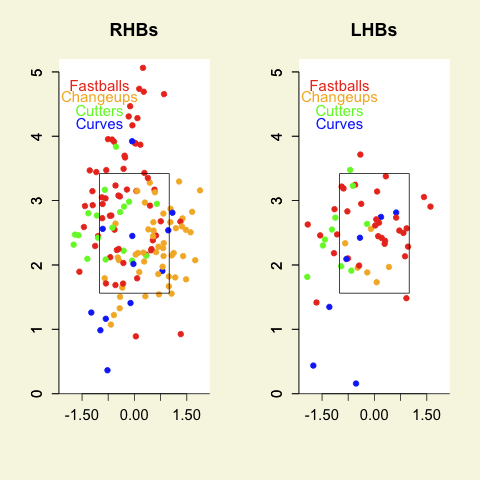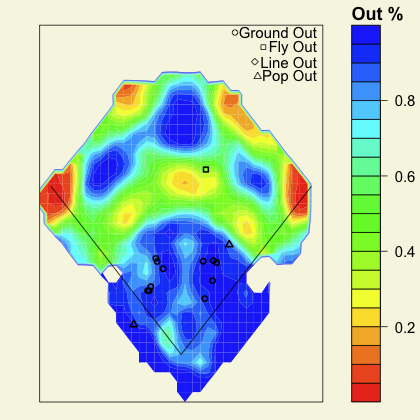Johnson Leads Florida’s Rotation
Over the weekend the Marlins swept the Phillies to move within four games of them in the NL East and three games out of the Wild Card lead. The Marlins are a real surprise this year, as some projected them to be worse than the Nationals. Last night Josh Johnson won the game for the Marlins, pitching six innings of four-hit, one-run ball while striking out 6, walking only one and getting seven ground balls on 14 balls in play. Johnson has been great this year, doing everything a pitcher should do, getting lots of strikeouts and ground balls while limiting walks. He has a FIP just over 3, good for ninth in the league.
Johnson has come back from his 2007 Tommy John surgery in a big way. His fastball averages over 95 mph, third highest among starters and his slider averages 86.4 mph, is one of the ten fastest. He also throws a changeup.

As you can see he throws a four-seam fastball with a good 10 inches a rise. This is really interesting as he is a ground ball pitcher; he gets over 50% of his balls in play on the ground. Most ground ball pitchers do that with a sinking two-seam fastball, like Derek Lowe, or get their groundballs on a slider or curve, like Brett Anderson. Johnson’s four-seam fastball induces 50% ground balls, even though it has 10 inches of rise. He is able to do this by locating it low in the zone.

The difference appears subtle, but over the course of the a season has a huge effect. This placement makes Johnson’s four-seam fastball a ground ball pitch, unlike most four-seam fastballs. He is able to locate his ‘rising’ fastball low in the zone. Here is how he uses his three pitches to lefties and righties.
+----------+-------+-------+ | | vRHB | vLHB | +----------+-------+-------+ | Fastball | 0.66 | 0.67 | | Slider | 0.30 | 0.19 | | Changeup | 0.04 | 0.14 | +----------+-------+-------+
The slider is a strikeout pitch getting lots of whiffs and out of zone swings, but also lots of fly balls. His changeup is not a strike out pitch, like Tim Lincecum‘s or Rich Harden’s. It gets very few whiffs and out of zone swings, but is an extreme ground ball pitch (over 67% ground balls per ball in play). This leads to a very interesting platoon split.
+--------+--------+--------+ | | vRHB | vLHB | +--------+--------+--------+ | OPS | 0.646 | 0.713 | | K/PA | 0.228 | 0.179 | | BB/PA | 0.073 | 0.099 | | HR/BIP | 0.033 | 0.019 | +--------+--------+--------+
His slider is much better than his change and he fastball has a normal platoon split, so has a whole he has a pretty big split. He can locate his slider well in the zone and gets lots of whiffs with it, but it induces FBs. As a result against RHBs he gets strikeouts and walks them rarely, but they hit more HRs against him. Against LHBs he goes with his changeup which gets few whiffs or out of zone swings, but lots of ground balls. So he actually gives up fewer HRs against lefties.
Josh Johnson is one of the ten best pitchers in the game and a valuable asset to the Marlins in their playoff push.







